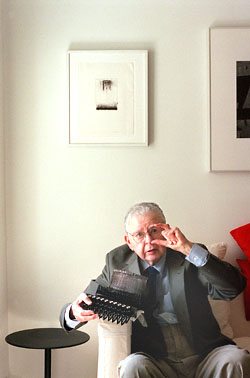Albert Szabo, Artist
The Big Picture: A snapshot of the Harvard Community

“If you watch carefully, you can see the Earth move,” says Albert Szabo, pointing to a rainbow sparkling on the back of a black leather chair. As the Earth rotates, he explains, sunlight shining through the prisms he has fastened to the window cause bands of colored light to migrate around the room.
Szabo, tall, neatly dressed in jacket and tie, grips the back of his walker to steady himself. Continuing his tour of the impeccable, light-filled living room, he points to each item of furniture in turn.
“That’s a Breuer chair,” he says in his soft, slightly muffled voice. “That’s a Corbusier chair, that’s a Mies van der Rohe table, that’s a Wagenfeld lamp – and the recliner? … that’s from Relax-a-Back. I used to sit in that when I was recovering from my heart operation.”
Szabo, 76, retired from the Graduate School of Design in 1996, having served there 42 years, longer than any other GSD faculty member. An architect by training who studied with some of the great designers of the Bauhaus school, he now spends his time creating sculptural pieces out of found materials. An exhibition of his work can be seen in the Carpenter Center gallery.
His workroom is a converted walk-in closet in the apartment he shares with his wife, Brenda, also an architect. The space is tiny, about the size of a small galley kitchen.
“The advantage of such a small space is that since I’m in the falling mode of Parkinson’s disease, it doesn’t give me any room to fall.”
The innards of a manual typewriter rest under bright lights on the workbench, surrounded by screwdrivers and pliers. Szabo has created a series of works from the old machines, disassembling them until he arrives at their essence. “It’s important not to go too far,” he says.
He mounts them in shadow boxes, adding a favorite quotation and some bits of imagery to amplify the meaning. There are 15 of these assemblages in the exhibition, representing everyone from Goëthe to Edith Wharton to Bartolomeo Vanzetti.
One of his favorites is still the first one he made – an IBM Selectric, its alphabetic spheroid nestled amid springs and levers beneath a human mouth. The quotation is from the prophet Ezekiel: “I have spoken and I have saved my soul.”
We serve the public interest! Interesting people, interesting jobs, interesting hobbies – we want them in the Big Picture. If you have an idea for the Big Picture, give us a buzz at big_picture@harvard.edu




